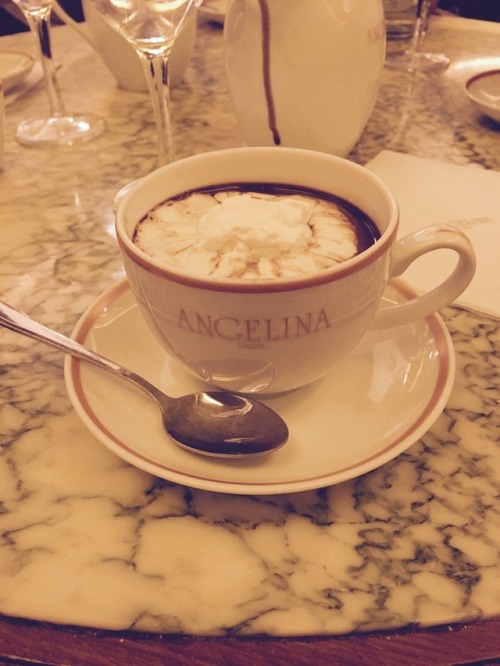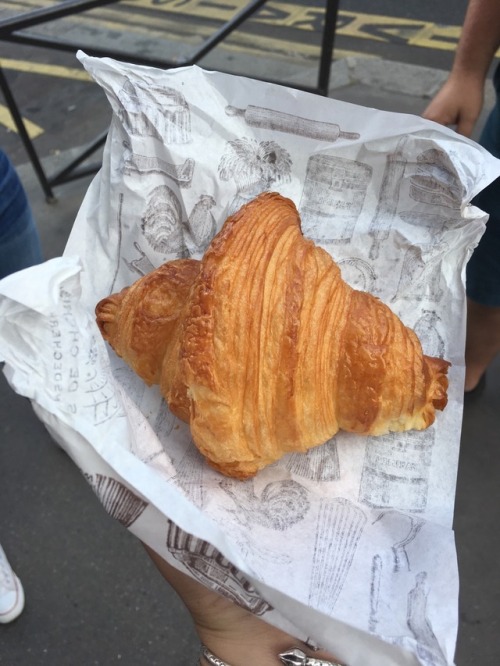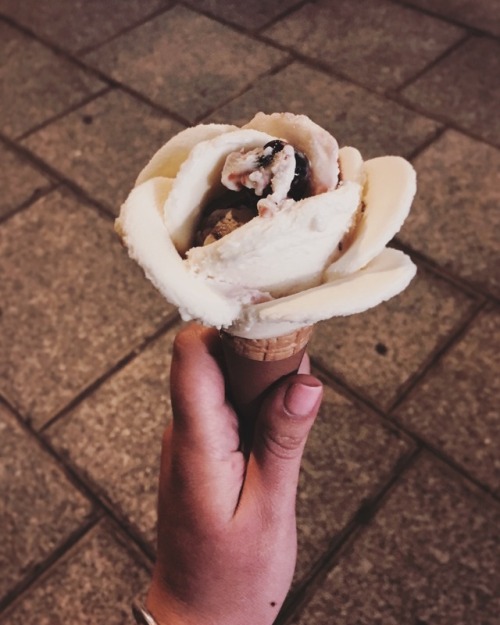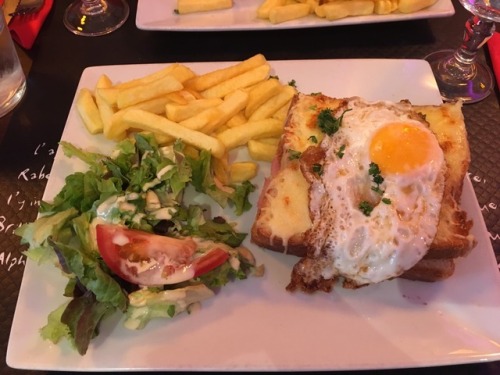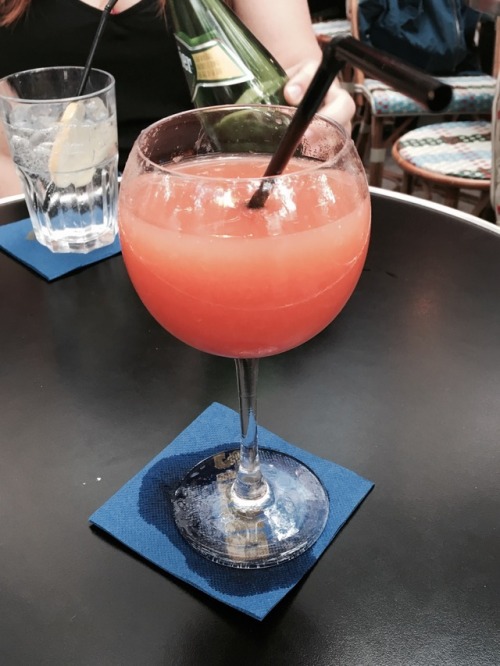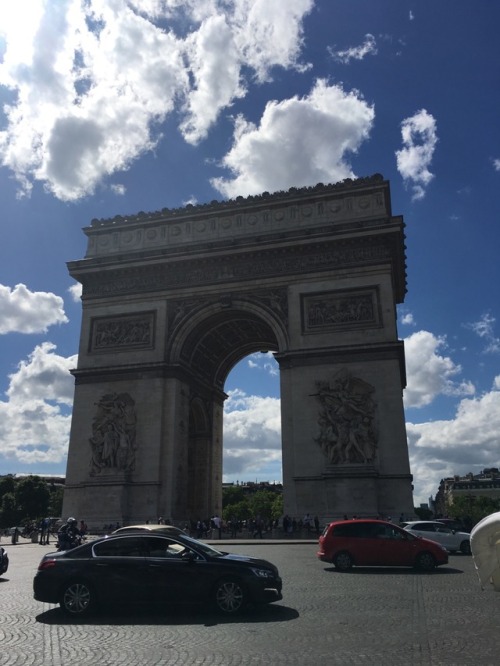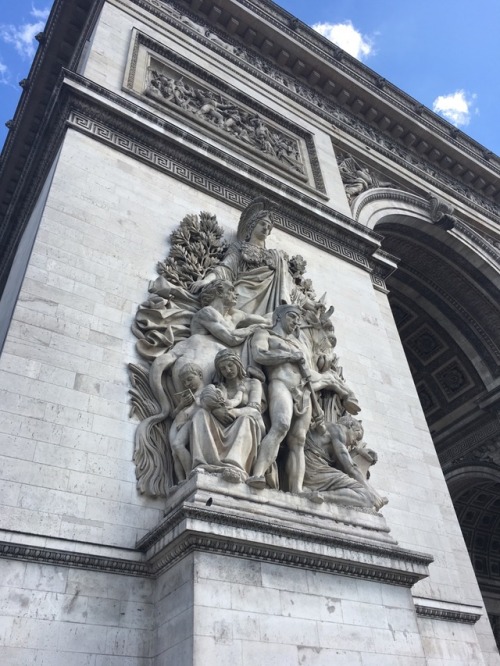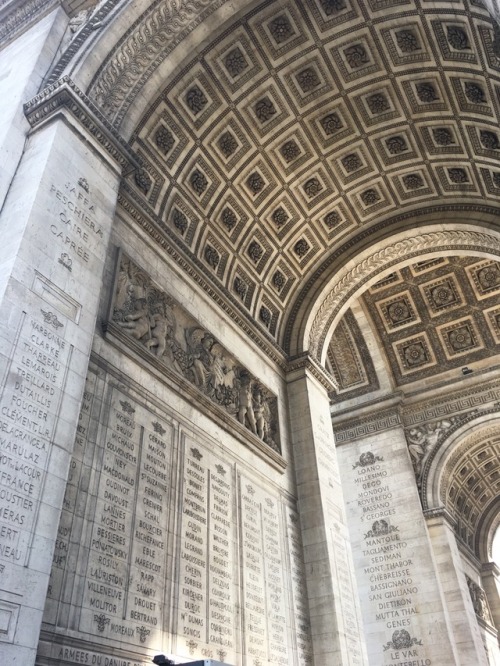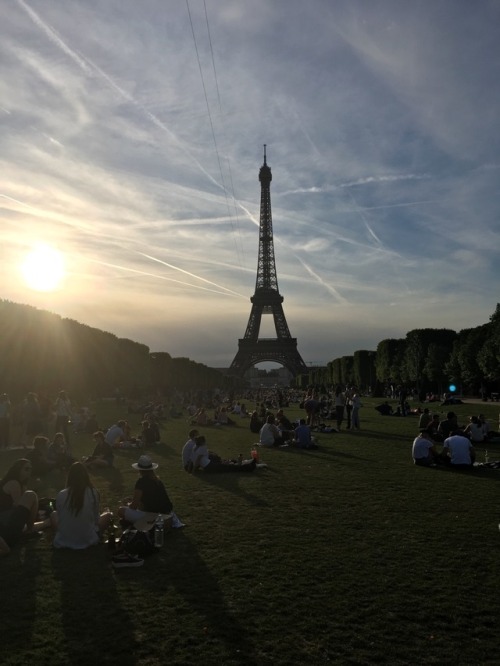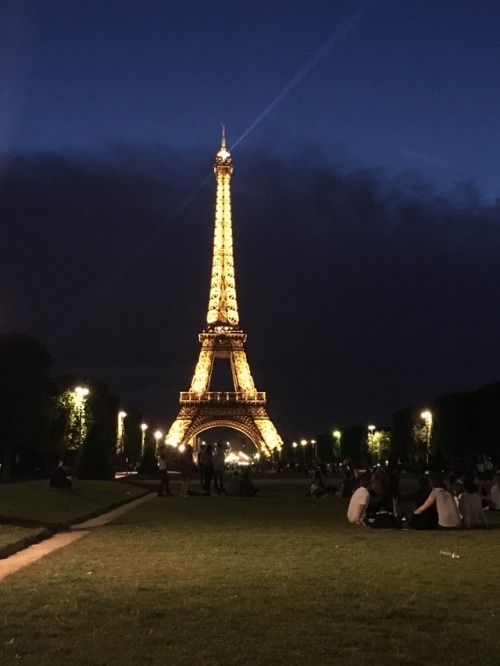#scsu2017paris
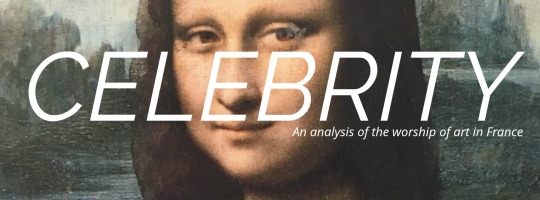
In Paris, France, art culture is alive and well. Home to some of the most renowned museums in the world, such as the Musée du Louvre, Musée d’Orsay, and Centre Pompidou, it seems as though the largest celebrities are the collections of art throughout the city. Visitors from all over the world flock each day to the Louvre to view classics like the Mona Lisa,Victory Angel, and Venus de Milo. In 2016 alone, the Musée du Louvre saw approximately 7.3 million people. (Source) Each person, upon entry, is immediately bombarded with reminders of the most popular works in the entire 38,000+ piece museum. Placards usher visitors through the corridors, promising to guide them to La Jaconde, and in turn leading them to the visitor dumping ground, piling them onto the sweaty heap of selfie-stick-wielding tourists, bloodthirsty for a peek at Mona Lisaherself.
Have you ever asked yourself why the Mona Lisa is so famous? It isn’t the epitome of fine art by a long shot. Like a Kardashian, La Jacondeis most likely famous because of scandal. In 1911, the painting was stolen from the museum after hours. The theft made international news as the entire world tuned in to find out what happened to the da Vinci original. After it was found, replaced, and vandalized a few times, it got new digs behind bulletproof glass and a partition, and thus the crowd formed. Suddenly, visitors were turning their backs on the other priceless works in the museum to make a bee-line for the swarm around the drama-magnet painting.
The public continues to drink in what the Louvre PR staff pumps out throughout the museum, collecting in pools around the Victory AngelandVenus de Milo. When they are finally through, they ring out their consumerist drool in the gift shop, emptying their wallets over anything and everything with the Mona Lisa on it. Shelves are coated in the iconic smile and captivating eyes adjacent to staggering Euro signs. Pop art models of Venus de Milo are arranged artfully at the entrance, hypnotizing passersby to drop their cash at the feet of the museum staff without even checking the price tag. Why? Because I’ve seen the real thing, and the countless pictures I took from every possible angle is not enough to commemorate that time I saw the most famous pieces of art ever.

The crowd around the Mona Lisa on a standard Monday afternoon. Note how few people are actually looking at the painting itself instead of through their camera.

Looking back at the sea of Mona Lisa visitors which nearly fills the small gallery room. The other works in the room are commonly neglected by the thousands of people who cycle through every day.

A smaller, but still congested crowd around Venus de Milo. This piece, like La Jaconde, is placed in the middle of the room, perhaps for ease of access.
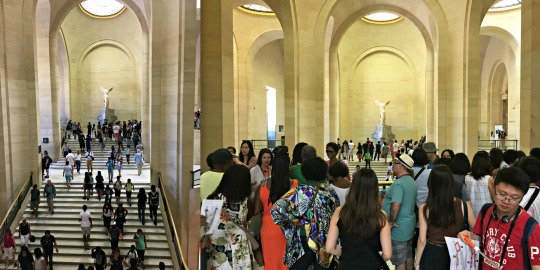
With the Victory Angel at the top of the stairs, mobs pose a problem for the traffic flow of the museum. Some people will retreat to the balcony opposite the sculpture, creating their own sky box of viewers.
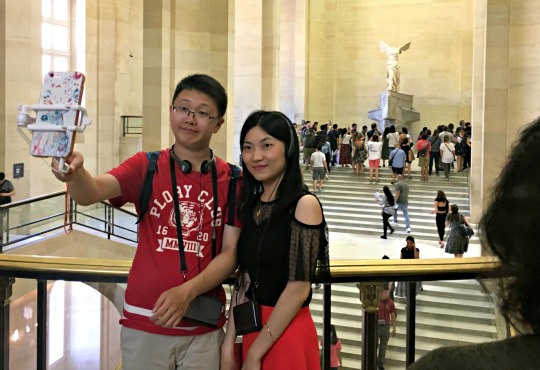
A new 21st century dimension to this phenomenon is the selfie culture. It is no longer enough to simply take a picture of the art. The amount of people with their backs to the piece in order to get in a picture withit seems counterproductive. Tweeting that you saw the Victory Angel is inaccurate, unless you have eyes in the back of your head.

Visitors commonly have to squeeze and elbow through the ravenous crowd outside the Mona Lisa at the Louvre. If you didn’t have claustrophobia before…
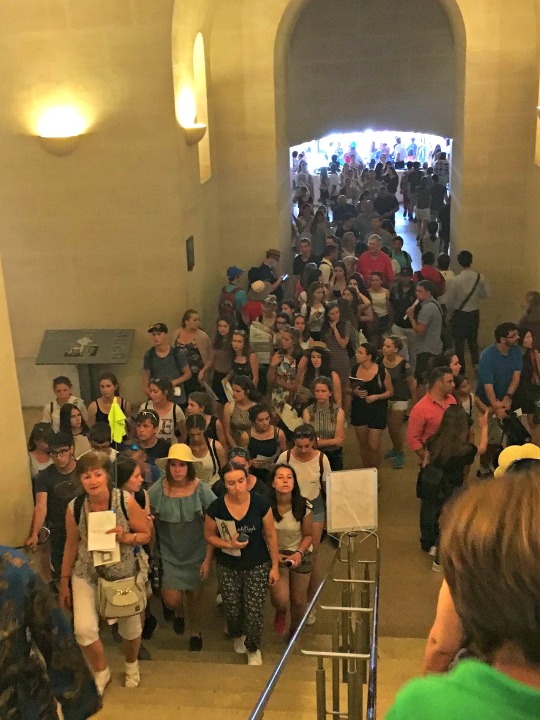
A fraction of the amount of visitors to the Louvre every day. Tour groups create waves in traffic throughout the museum, and have a tendency to linger at our favorite 3 pieces.

Gift shop display of Venus de Milo figurines in various colors. It’s almost refreshing to see something that isn’t the Mona Lisa, but these colorful little ladies are like chum for gift shop customers. At the end of the day, you’re going home with Lisa.
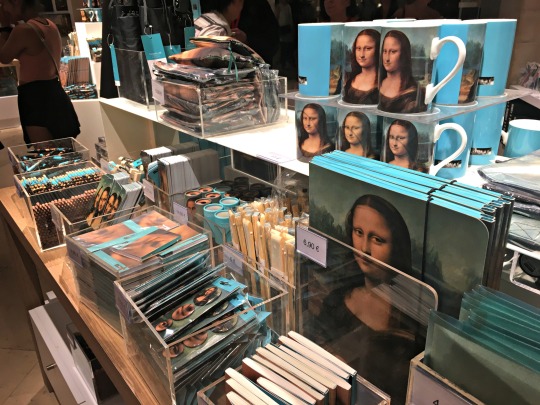
One of the many Mona Lisa displays in the Louvre gift shop. There’s a famous controversy about what her smile means. I cracked the code. It says, “BUY ME”.

The consumerism of the Mona Lisa extends outside the museum as a motif in advertisement. This ad is in a Paris metro station, but La Jaconde can even be found on billboards off I-84 in the United States.
Worldwide, in France, the US and beyond, the popularity of art is defined not by its quality, but rather by its value as a product to sell to an ususpecting, unquestioning, consumerist public.
This week, I visited 2 buildings in the Art Nouveau style. This style was popular in the late 1800s to early 1900s. It can be identified by the curving lines, ornate decoration, natural forms, and asymmetrical facades. In France, the style was a protest against the strict requirements for building facades under Haussmann.

The first building I visited was the Lavirotte building in the 7th Arr. I was most impressed by the decorative aspects of this building, namely the statues and busts that adorned the facade. The building was surrounded by “normal” buildings, making it that much more notable.


Next, I hopped over to the 16th Arr to visit Castel Beranger. After seeing the first building, I must admit to being slightly underwhelmed by this one. I did enjoy the design of the entrance gate. The curving, fluid forms were whimsical and intriguing in contrast with the stone siding. The Art Nouveau-ness was subtle, but definitely present in the door, pillars, and railings.
In Paris, grocery shopping is an event. Whether it is an open air market, a small Franprix, or a hugely extravagant supermarket, it is a much different experience than the United States.
Yesterday, my friends and I tried two different types of markets. We started at the Marché Beauveau-Marché d’Aligre, one of the most famous semi-permanent markets in Paris. The building was an industrial pavilion that stretched nearly the length of the block. We entered to an eerily vacant market, surrounded by fish, meats, fruits, veggies, and cheese. It was not at all what I was expecting. I was anticipating the hustle and bustle of people all round, barking at cheese vendors and carefully selecting grapefruit. Instead, the aisles were quiet, and the shopkeepers sat patiently watching my friends and me awkwardly gaze over the baskets of tomatoes and avoid eye contact with the dead fish. Strangely, it left me with a similar feeling to being in a private art gallery; it wasn’t strictly forbidden to speak, but the atmosphere was such that silence felt most appropriate. While it wasn’t what I expected, I was intrigued by the selection and watching out fellow shopper order meat.
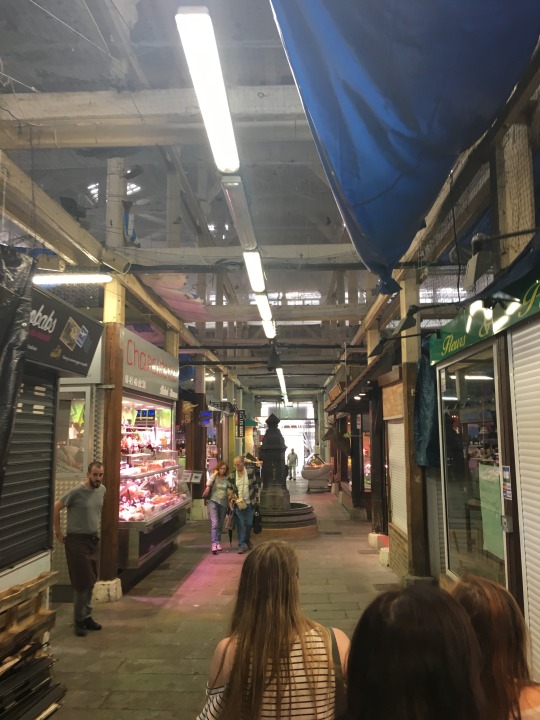
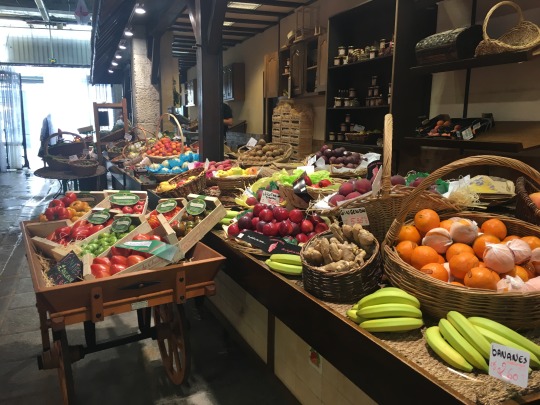
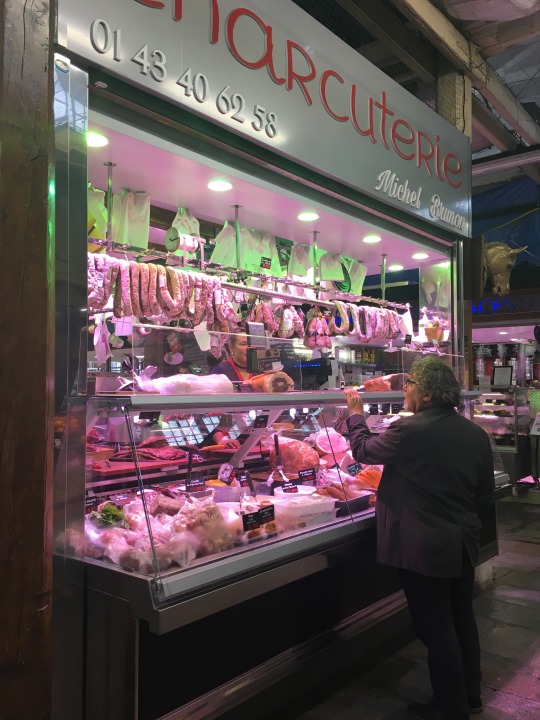
Afterwards, we headed over to Grande épicerie du Bon Marché, possibly the most extravagant supermarkets I have ever seen. Aisle after aisle is stocked with the most decadent produce, desserts, jams, condiments, pastas, and more. The quality of the food was palpable simply by looking at it. As the floors ascended, there was furniture, kitchen appliances, dishes, and more inedible but relevant products. I was overwhelmed and impressed, but indulged myself in a macaron from the bakery, which was just as delicious as it looked. I was without a doubt more dazzled by this market than the other.



In the year 1840, the Palais d’Orsay was complete, a new meeting place for the council of state. By 1871 the Paris Commune took power. They emptied the Palais, moving all books, archives, and art to Versailles. That year, on May 23rd, the vacant d’Orsay was vandalized and burned by soldier arsonists in protest of Napoleon III.
The site was purchased by Compagnie Paris-Orleans. They demolished the burned buildings and built a train station and hotel, the building which still stands today. The building is of a Beaux-Arts style, as evidenced by the flat roof, arched windows and doorways, pilasters, and symmetry. The train station was opened for the 1900 World Expo in Paris.
In 1939, new trains circulated through Paris which were too long for the platforms in d’Orsay. It was commissioned to become a museum in 1974, and was completed in 1986. Over 2000 works of art were installed over the course of 6 months from the Galerie Nationale du Jeu de Paume.
Today, Musee d’Orsay houses work from the 19th and 20th century. It boasts the largest collection of impressionist and post-impressionist art in the world, showcasing work by Monet, Degas, Manet, Van Gogh, and more.
This week, we visited the Musee d’Orsay. It was a unique museum and was definitely lots of fun. I inspired a scavenger hunt to find 5 specific paintings, which urged everyone to explore the entire building and visit every exhibit. It was definitely a one-of-a-kind museum and experience!
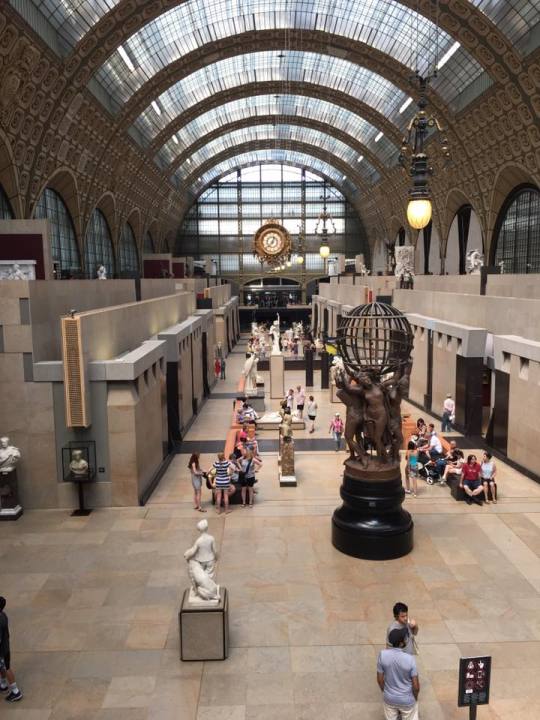
If there’s one thing I have learned through taking art history, it is that you can never rule out an artistic movement. As a young artist, I would always say that I did not like impressionism. I thought it was disorganized and rushed, unappealing to the viewer, and I could not understand why people liked it so much. Upon studying it, I began to understand it a little bit better. Impressionism was a groundbreaking movement in art. There was nothing like it when it came to be, and it was one of the most controversial movements in art history. The movement focuses on light, color, and the fleeting moments of everyday life.
This week, I got the opportunity to visit Giverny, the hometown of Claude Monet. Prior to my visit, I was not a fan of Monet’s work. Being the art snob that I know I am, I thought to like Monet was too “mainstream”. The waterlilies didn’t impress me, and his haystacks could put me to sleep.
My, how things have changed

Walking through the home and gardens of Claude Monet was surreal, and nearly moved me to tears. Not only was his house my dream house, I immediately understood why he was so inspired by this property. The pond and gardens feel like a fairytale, and weaving through the paths and bridges felt like instant therapy, enough so to distract me from the throngs of tourists pushing me along.
In my mind, it was just me, Monet, and the lilies. The colors began to decompose and separate like whole milk, and I could see the water like Monet had, bright and whimsical, strung together by confident brushstrokes. I was in awe. I finally got impressionism.

Monet’s home is covered with art. His studio is filled floor to ceiling with original pieces in various states of finish and refinement. The painting above was my favorite, and I bought a print of it on the way out.
The interior of the home is beautiful, with bright yellows, blues, and greens. The natural streamed in through lace curtains, casting perfectly abstract sunbeams on the floor and furniture. I danced around the home, dreaming about what life must have been within these walls, constantly surrounded by inspiration.

I’ve said it before, but I think I really mean it this time: this was the highlight of my trip so far. It was absolutely surreal, and I left with a much higher appreciation for impressionism and art as a whole. I hope to someday achieve the level of inspiration that Monet had access to literally in his own backyard. I feel so fortunate to have seen it myself.


This week I went to Versailles! I was unsure of what to expect, as I had heard mixed reviews. Many of my friends have deemed Versailles as an overrated, overcrowded tourist trap. I was prepared to feel the same way, but let my mind open, especially to the history throughout the halls.
Versailles was built as the royal palace that we all know in the 17th century by Louis XIV. The chateau was home to the king himself, as well as his family and his entire cabinet. Each day, the rooms would bustle with activity. Residents and visitors alike watched the king’s every move, and were painfully aware that they too were being watched. Outside the chateau stretches the expansive gardens and grounds designed by Andre le Notre. The gardens were and continue to be one of the most magnificent examples of jardin a la francaise in Paris. Each fountain was personally tested by the king himself upon installation.

Around the time of the French Revolution, the king moved out, and the chateau and gardens of Versailles began to atrophy. The war took its toll, and what wasn’t in disrepair was damaged by vandals and battle. Restoration projects have been most successful, with only a select few features of the grounds still damaged.

With this knowledge, my visit to Versailles was much more meaningful. Through the steadily controlled wave of visitors, I coasted like a member of the king’s royal cabinet, looking for each subtle clue of history, such as the wear on the wood floors, or the cracks in the faded ceilings. The famous Hall of Mirrors was absolutely breathtaking, and as predictable as it may be, it was my favorite part of the interior. Upon our exit, we got lunch as a group, and then a few of us rented a boat to row along the Grand Canal, an experience which made us feel like nobles and reminded me of Morisot’s Summer’s Day.


After our row down the canal, we continued to wander the grounds and visit the Jardin du Roi, where we sat for a while and reflected on the day. My visit to Versailles was surreal and meaningful, and one I won’t soon forget.
Let’s be honest, I came to Paris for the food. I made it my goal to try everything I could, from croque monsieurs to macarons and I have loved every bite.
The most surprising food for me was escargot. I have never liked seafood and was nervous for my first snail. My advice? Try the snails. You will not regret it. There is nothing better than that warm, buttery morsel of flavor contained inside an unassuming shell.
As far as desserts go, Paris could very well be the pastry capital of the world. I thought I knew what a croissant was. One bite into the lightest, flakiest midday snack I have ever had and I was immediately a croissant snob. I don’t know how they do it, but man, do they do it well.
Paris has not disappointed me yet, and I don’t suspect that it will. Even a simple baguette with brie overlooking the Eiffel Tower with friends far surpasses any chain restaurant or turnpike diner back home.
Post link
Yesterday we went to Vaux le Vicomte, a château outside of Paris. It was constructed in the 1600s for Nicolas Fouquet. The lavish interior and deceptively expansive jardins were breathtaking, and a lovely way to spend a hot afternoon. We explored the building and grounds, viewing the property from above, as well as trekking out to the famous Hercules sculpture about a mile into the jardins.
Last night was surreal. Definitely my “aha” moment, and without a doubt the night I fell in love with the city of Paris.
Post link
The Louvre houses thousands of impressive and influential artworks. The halls and rooms are lined wall to wall with paintings and sculptures. Millions of people from around the world flock to the iconic museum to view one 30x21 inch painting hung on its own wall behind glass and body guards: the Mona Lisa.

Mona Lisa was painted by Leonardo da Vinci in the early 1500s. It is a half length portrait of Lisa del Giocondo commissioned by Lisa’s husband. Lisa is depicted alone sitting at three-quarters view in front of a natural background. She makes eye contact with the viewer, and sports her famous, ambiguous smile.
The painting has traveled quite a bit, starting in Italy, before da Vinci was invited to live in Paris as King Francois I’s benefactor. Mona Lisa stayed in the Palace of Fontainebleau for a while before moving the Versailles, and finally to the Louvre after the French Revolution. It was stolen and recovered to the Louvre in the early 1900s.
WhenMona Lisa was created, she was a controversial image. In the time period, it was unheard of to paint a woman looking out at the viewer, and especially unaccompanied by her husband. Her body language and confidence would be interpreted as that of a prostitute. The painting was groundbreaking and immediately influential. References to her pose and expression are apparent in countless works after her. She has also inspired movies, conspiracy theories, songs, and infinite other expressions.
Fame

TheMona Lisa has been called the world’s most famous painting. She has become a pop culture icon. Her face is plastered on mugs, billboards, shopping bags, and of course the cover of countless Art History 101 textbooks. You can’t escape that iconic gaze.
She has also been called the Kardashian of art. Though she has a colorful history, the majority of people who elbow through the crowd surrounding her rendering are unaware of her past. They only know that this is theMona Lisa. She is by no means the height of art or the perfect example of technique. She is not in any way the only piece to make an impact. And yet, people swarm her like blood-sucking paparazzi thirsty to snap the cover of Us Weekly.
During my stay in Paris and visits to the Louvre, I have had the displeasure of witnessing this gawking mob with my own eyes. Even at my first visit, when I was just another tourist among them, I was baffled and almost disgusted by the masses standing shoulder to shoulder, cameras outstretched, drooling over the one thing they must see in one of the greatest museums in the world.
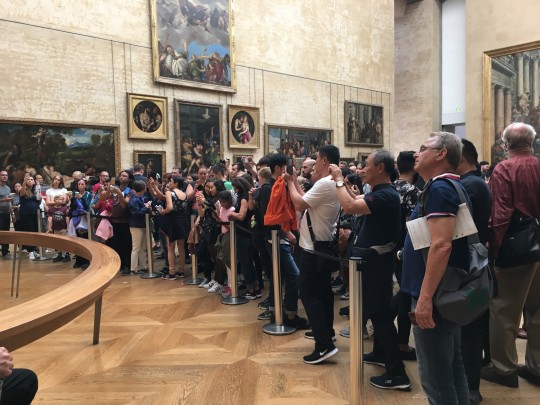
I can only wonder how the Mona Lisa feels. Launching into the spotlight is difficult for anyone, but she didn’t ask for this. Why, of all da Vinci’s breathtaking works, why her? Why this piece? Bulletproof glass, a wooden rail, two bodyguards, and a fabric rope barring the spectators from getting too close. She sees thousands of people a day, and I can only imagine she’s lonely on her private wall. I wonder if she feels guilty about drawing people away from the other pieces in the room, either by sucking the public in like a fly to her web, or repelling visitors completely from the room as a whole to avoid the buzz in the middle.
I wish I could tell the Mona Lisa I’m here for her. I wish I could get up close. Not just to gawk at her fame, but to strip away the souvenirs, the layers of security, and especially her superficial following, and appreciate her for what she truly is: a lovely, influential, well done portrait of a woman who has the inexplicable ability to draw people in and never let them go, but also just another painting.
Yesterday we paid a visit to Basilique Saint-Denis, a church in northern Paris, and final resting place for French nobility. The nave is surrounded by the coffins of kings and queens, adorned with statues of their likeness. The tombs range in age, size, extravagance, and animation. They are illuminated by the gorgeous stained glass windows of the church, casting shades of blue and red across the statues of generations of royal families.
The most breathtaking resting place to me was the tomb of Anne de Bretagne and her second husband Louis XII. The mausoleum houses life sized, realistic sculptures of the royal pair, naked, stomachs eviscerated and sewn up, and motionless in death. They are surrounded by the twelve apostles, four cardinal virtues, and carved scenes of the Italian wars. Above them kneel the sovereigns in prayer. (Source)

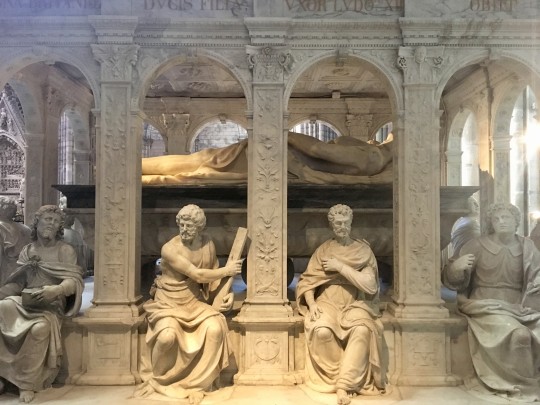
I was initially drawn to this tomb because of the artistic craftsmanship throughout the structure. Each sculpture is impeccable, showing the unique features of each figure represented. Upon further observation, I noticed that Anne’s figure was completely naked. There were other naked figures in the church, but all had at least a hand covering their breasts and protecting their modesty. Anne lies with her head tilted back and chest bare, which I found to be an interesting choice in a church setting.
I was mesmerized by this mausoleum. It, and the church in which it is housed, are absolutely beautiful. Weaving through the caskets is not an experience I will soon forget.

